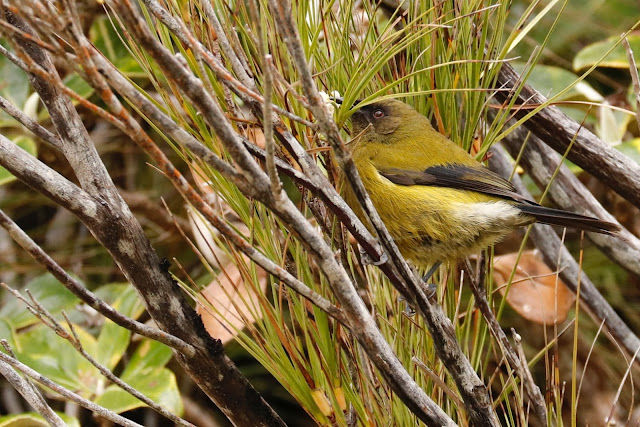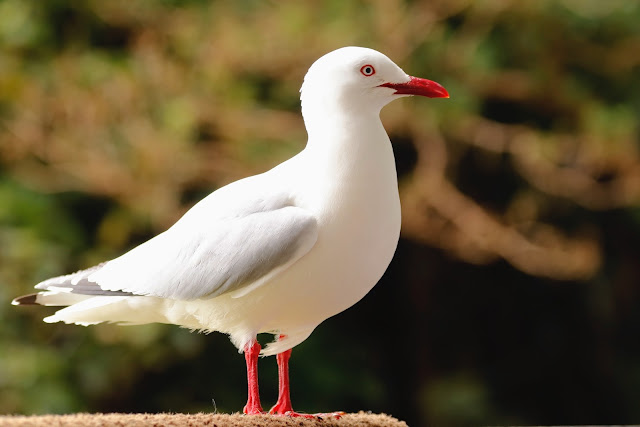Recently I had the opportunity spend some time on Ulva Island in Patersons Inlet, Stewart Island New Zealand.
My aim was to photograph as many birds that lived on the island as possible. I came away disappointed in not seeing a kiwi but hearing them on numerous occasions and seeing where they had been on the beaches.
Below is a selection of not only birds but some other interesting fauna as well.
South Island Kaka Nestor meridonalis
These large raucous parrots seem to be the dominant species in the bush although the tuis have been seen to defend their territory with some vigour.
These birds with their powerful beaks can be seen stripping the bark off trees looking for insects like wetas to feed on.
Red-crowned Parakeet (Kakariki) Cyanoramphus novaezelandiae
Yellow-crowned Parakeet (Kakariki) Cyanoramphus auriceps
 |
| A nicely composed shot but some preening would have been desirable before "posing". |
South Island Robin (Toutouwai) Petroica australis
The South Island Robin abounds here and they are very friendly and not afraid to get quite close. They like following you as you disturb the leaf litter on the tracks allowing small insects to be caught and eaten.
South Island Tomtit Petroica macrocephala
Yellowhead (Mohua) Mohua ochrocephala
This photo has some noise as ISO was at 6400 to compensate for the fact that it was overcast and quite dark and also the fact that these birds are quite active and move rapidly. This was one of a small flock of around 6 birds on the forest floor about 10 m away.
However one of the Yellowheads came a sat on a small bush about 2 m aways for a good minute so or so but remained with the distracting small branch in front. I have not attempted to "photoshop" it out as I believe that photos should show what it was actually like at the time. I do, however crop most photos to remove some of the distractions and to better frame the subject, but little other processing has occurred.
Tui Prosthemadera novaeseelandiae
South Island Saddleback (Tieke) Philesturnis carunculatus
 |
| Juvenile Saddleback |
 |
| Adult Saddleback |
 |
| Feeding time |
Bell Bird (Korimako)
These nectar feeders were elusive but there song gave their presence away.
This first photo was taken deep in the bush with limited light, hence high ISO and lots of noise in it. They have curved beaks and long tongues. I've included this photo because the tongue is evident.
 |
| Taken at Westend Beach. |
I have a much better Korimako photo taken at the White Heron colony near Whataroa.
Kereru (NZ Wood pigeon)
These heavy berry feeders don't make much noise and keep very still often resting on branches a few metres above ground. Several times they startled me as I didn't see them until they flew away as I walked underneath. Their swooshing sound of the wings when flying are very distinct.
Oyster catcher
These birds squawk loudly to advertise their territory on the beach. The same pairs of birds don't go very far away and can be guaranteed to be seen in the same places on following days.
Red billed gull
Hooker sealions.
These large mammals are frequent visitors to Stewart Island. They come up from the breeding colonies on Auckland Island. The Department of Conservation has signs on all the tracks leading to the beaches on Ulva Island to warn visitors not to get too close to them.
 |
| Get too close and this is the reaction. They have bad breathe too. |
Thanks to Alan and Ian who then did a great impression of an animated scarecrow because he promptly turned around and headed back to the water.
 |
| A disdainful look before slipping back into the water. |
Wetas
New Zealand has around 70 weta species. some are up to 5-10cm long. I found several, I think 3 different species in a wood pile. Whilst getting my camera ready, a weka appeared and waited until I had finished then picked one up and took it away.
 |
| This one was about 15-20 mm long with longer feelers. |
 |
| Wetas have a characteristic long spiked "tail" |
Weka
A very common ground bird endemic around most parts of New Zealand. Some tourists have mistaken them for kiwi!
 |
| Adult weka, they were everywhere on Ulva. |
The weka have had a successful breeding season and many chicks were seen all over the island. Wetas form an important part of the food chain and those from the wood pile were quickly taken away by the parents to their nearby chicks.
 |
| Weka chick |
This concludes my selection of birds and other animals from my visit to Ulva Island. My next step is to collect together my Top 10 bird photos from here and elsewhere including a recent trip to the White heron colony at Whataroa.
More wildlife photos of trips to Somes Island and South Canterbury are linked here. Also there is a selection of 10 top bird photos. Birds and animals from safaris in Tanzania, Africa can be found here.
































